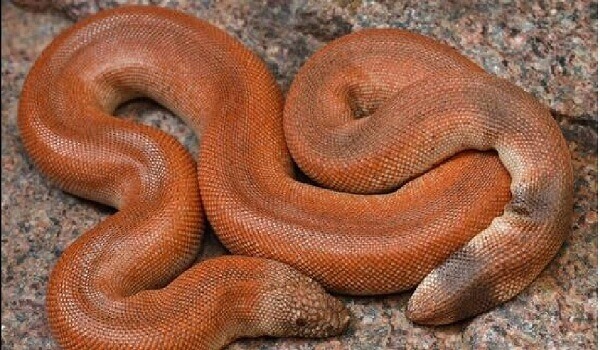According to a report by the Wildlife Conservation Society, the illegal trade of 172 red sand boa snakes in the last five years has almost put the endangered reptile species on the verge of extinction.Maharashtra tops the list with 59 cases of trafficking followed by Uttar Pradesh (33).
Red Sand Boa
- Red Sand Boa (Eryx johnii) is a species in the subfamily Erycinae of the family Boidae.
- It is commonly called the Indian Sand Boa is a non-venomous species found throughout the dry parts of the Indian subcontinent.
- It is ovoviviparous and nocturnal and spends the majority of its time under the ground.
- Distribution: The species is endemic to Iran, Pakistan, and India.
Appearance
- It is a primarily reddish-brown and thick-set snake that grows to an average length of 75 cm.
- Unlike most snakes, the tail is almost as thick as the body and gives the reptile the appearance of being “double-headed”.
Ecologically importance
- Like other snake species, the Red Sand Boa also plays a significant role in the ecosystem by maintaining a healthy population between prey and predator.
- It feeds on rodents, lizards, and even other snakes.
Conservation Status
- IUCN: Near Threatened
- Wildlife (Protection) Act, 1972: Schedule IV
- CITES: Appendix II
Wildlife Conservation Society (WCS)
- It is a non-profit company (under section 25) and is compliant with all Indian regulations.
- In line with the global mission, the overarching goal of WCS-India is the protection and conservation of the natural environment, its flora and fauna.
- There is protection of wildlife and wild places especially in India.
Wild Life Protection Act, 1972
- The Act provides the legal framework to enact and regulate the conservation of various species of wild animals, management of their habitats and trade in products obtained from various classes of wild animals.
- The Wild Life (Protection) Amendment Act was last amended in 2022 and the Act came into force from 01 April 2023.
- According to section 49N of this Act, any person breeding in captivity or causing artificial propagation of any scheduled specimen listed in Appendix I of Schedule IV to the Wildlife (Protection) Amendment Act, 2022 It is necessary to apply for a license within 90 days of its implementation.

